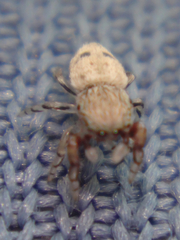Wasp spider
Argiope bruennichi
Arachnida Argiope bruennichi, commonly known as the wasp spider, is a striking member of the orb-weaver family. This visually fascinating spider is renowned for its bold, striped markings, closely resembling those of a wasp, which serves as a deterrent to predators.
In the Comunidad Valenciana, this species is widely observed in open fields, grasslands, and gardens, where it constructs its large, spiral web. Its presence is a telltale sign of a healthy, balanced ecosystem. The webs are notable for their characteristic zigzag patterns, called stabilimenta, which experts believe may serve to attract prey or provide camouflage for the spider.
- Appearance: Females are considerably larger than males, boasting colorful black and yellow striped abdomens. Males, only around a quarter of the female's size, are brownish and much less vibrant.
- Diet: Wasp spiders feed primarily on insects such as grasshoppers and other flying insects, which they ensnare in their webs.
- Reproduction: Mating occurs in the summer, after which the female spins an egg sac that can contain several hundred eggs. The young spiders hatch and disperse the following spring.
- Behavior: The wasp spider is a non-aggressive species that poses no threat to humans. Its venom is not harmful, and bites are extremely rare.
- Local Name: In the Comunidad Valenciana, this spider is referred to as "escarabat de tigre" due to its distinctive coloration.
Conservation efforts focus on maintaining their natural habitats, as these spiders play a vital role in controlling insect populations and preserving the ecological balance. Observing the Arachnida Argiope bruennichi in its natural habitat is a testament to the rich biodiversity that the Comunidad Valenciana boasts.







